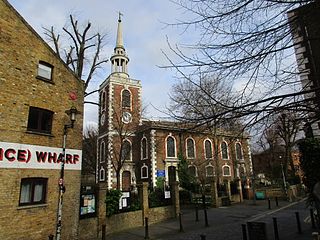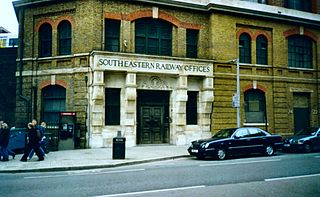
Southwark is a district of Central London situated on the south bank of the River Thames, forming the north-western part of the wider modern London Borough of Southwark. The district, which is the oldest part of South London, developed due to its position at the southern end of the early versions of London Bridge, for centuries the only dry crossing on the river. Around 43 AD, engineers of the Roman Empire found the geographic features of the south bank suitable for the placement and construction of the first bridge.

Bermondsey is a district in southeast London, part of the London Borough of Southwark, England, 2.5 miles (4.0 km) southeast of Charing Cross. To the west of Bermondsey lies Southwark, to the east Rotherhithe and Deptford, to the south Walworth and Peckham, and to the north is Wapping across the River Thames. It lies within the historic county boundaries of Surrey. During the Industrial Revolution Bermondsey became a centre for manufacturing, particularly in relation to tanning. More recently it has experienced regeneration including warehouse conversions to flats and the provision of new transport links.

Rotherhithe is a district of south-east London, England, and part of the London Borough of Southwark. It is on a peninsula on the south bank of the Thames, facing Wapping, Shadwell and Limehouse on the north bank, with the Isle of Dogs to the east. It borders Bermondsey to the west and Deptford to the south-east. The district is a part of the Docklands area.

A fire department or fire brigade, also known as a fire company, fire authority, fire district, fire and rescue, or fire service in some areas, is an organization that provides fire prevention and fire suppression services as well as other rescue services.

St. Olave's Grammar School is a selective secondary school for boys in Orpington, Greater London, England. Founded by royal charter in 1571, the school occupied several sites in Southwark, before establishing a location on Tooley Street in 1893. It moved to the suburb of Orpington in 1968, and has admitted girls to its sixth form since 1998.
Liverpool Salvage Corps was a service in Liverpool, England, founded and maintained by fire insurers, whose aim was to reduce the loss and damage caused by fires, to help mitigate the effects of fire and of fire-fighting and to salvage both premises and goods affected by fire. It was founded in 1842 and operated until April 1984, when its functions were transferred to the Merseyside Fire Brigade. Similar salvage corps also operated in London and Glasgow.

Tooley Street is a road in central and south London connecting London Bridge to St Saviour's Dock; it runs past Tower Bridge on the Southwark/Bermondsey side of the River Thames, and forms part of the A200 road.
Hays plc is a British multinational company providing recruitment and human resources services across 33 countries globally. It is listed on the London Stock Exchange and is a constituent of the FTSE 250 Index.

James Braidwood (1800–1861) was a Scottish firefighter who was the first "Master of Engines", in the world's first municipal fire service in Edinburgh in 1824. He was the first director of the London Fire Engine Establishment. He is credited with the development of the modern municipal fire service.

The London Fire Brigade (LFB) is the fire and rescue service for London, the capital of the United Kingdom. It was formed by the Metropolitan Fire Brigade Act 1865, under the leadership of superintendent Eyre Massey Shaw. It has 5,992 staff, including 5,096 operational firefighters and officers based at 102 fire stations.

The London Salvage Corps was maintained by the fire offices of London. The corps was first formed in 1865 and began operations in March 1866. It was inspired by the Liverpool Salvage Corps which had been formed in 1842, to reduce the loss and damage caused by fires, to help mitigate the effects of fire and of fire-fighting and to salvage both premises and goods affected by fire.

Captain Sir Eyre Massey Shaw KCB was the first Chief Officer of the Metropolitan Fire Brigade, and the Superintendent of its predecessor, the London Fire Engine Establishment, from 1861 to 1891. He introduced modern firefighting methods to the Brigade, and increased the number of stations. Prior to entering firefighting, Shaw was in the British Army, followed by a spell as Chief Constable of Belfast Borough Police.

The history of organized firefighting began in ancient Rome while under the rule of the first Roman Emperor Augustus. Prior to that, Ctesibius, a Greek citizen of Alexandria, developed the first fire pump in the third century BC, which was later improved upon in a design by Hero of Alexandria in the first century BC.

The history of fire brigades in the United Kingdom charts the development of fire services in the United Kingdom from the creation of the United Kingdom to the present day.

Commercial Union plc was a large insurance business based in London. It merged with General Accident in 1998 to form CGU plc.
Botolph Wharf or St Botolph's Wharf was a wharf located in the City of London, on the north bank of the River Thames a short distance downstream from London Bridge. It was situated between Cox and Hammond's Quay upstream and Nicholson's Wharf downstream. On the landward side, the wharf was accessed via Thames Street. It had a frontage of 78 ft (24 m). The wharf was used for at least a thousand years before being destroyed during the Second World War. A late 1980s office building currently occupies the site.

St Olaf House is a Grade II* listed building on Tooley Street in the London Borough of Southwark. The house was built on the site of St Olave's Church, Southwark between 1928 and 1932, and is now part of London Bridge Hospital.
Henry Stock (1824/5–1909) was a British architect. He served as the county surveyor for Essex for nearly 50 years, and as the surveyor and architect to the Worshipful Company of Haberdashers. The latter appointment led Stock to undertake a considerable number of educational commissions, but his primary field of activity was in the construction of manufacturing sites and warehouses in London.

















